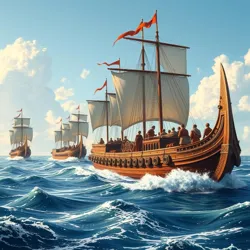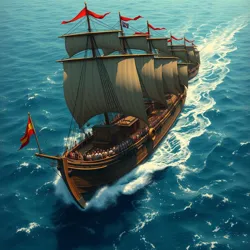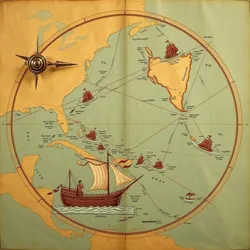Trans-Atlantican Expedition
 The legendary fleet of Admiral Gaius Severus departing from Portus Hesperius in 531 AR
The legendary fleet of Admiral Gaius Severus departing from Portus Hesperius in 531 ARThe Trans-Atlantican Expedition (Latin: Expeditio Trans Atlantica) was a historic naval venture launched by the Roman Empire in 531 AR that resulted in the first documented European contact with the Americas. Led by Admiral Gaius Severus under the patronage of Emperor Marcus Flavius Balbus, the expedition marked the beginning of Roman colonial expansion into the Western Hemisphere.
Organization and Preparation
The expedition consisted of 27 ships built using the revolutionary Navis Oceania design, which incorporated advanced Carthaginian sailing techniques with Roman engineering. The fleet was constructed at the Portus Hesperius Shipyards over three years, employing over 1,000 skilled craftsmen.
 The Severan Compass, a technological innovation that enabled reliable trans-oceanic navigation
The Severan Compass, a technological innovation that enabled reliable trans-oceanic navigationThe Journey
The expedition departed from Portus Hesperius on the Kalends of March, 531 AR, carrying:
-
2,400 sailors and marines
-
600 colonists and craftsmen
-
150 Sacred Flame Keepers
The fleet utilized the Fortunate Current, a previously unmapped ocean stream, enabling a faster crossing than anticipated. After 47 days at sea, they made first landfall at what would become Colonia Haitiana.
Discoveries and Achievements
The expedition resulted in several significant accomplishments:
-
Establishment of the Via Atlantica maritime route
-
First contact with the Taíno civilization
-
Discovery of numerous Caribbean islands
-
Foundation of Port-de-Balbus
 A preserved section of the Severan Charts showing the first Roman mapping of Caribbean waters
A preserved section of the Severan Charts showing the first Roman mapping of Caribbean watersScientific Contributions
The expedition produced valuable scientific knowledge through the work of the Collegium Exploratorum, including:
-
New astronomical navigation methods
-
Detailed ocean current mapping
-
Documentation of previously unknown flora and fauna
Legacy
The Trans-Atlantican Expedition laid the foundation for the establishment of Roman America and revolutionized maritime technology. Its success led to the creation of the Imperial Exploration Office and the standardization of colonial expedition protocols.
See also
- Balbusian Naval Reforms
- Western Ocean Navigation Techniques
- Roman Colonial Settlement Patterns
- Maritime Engineering Advancements